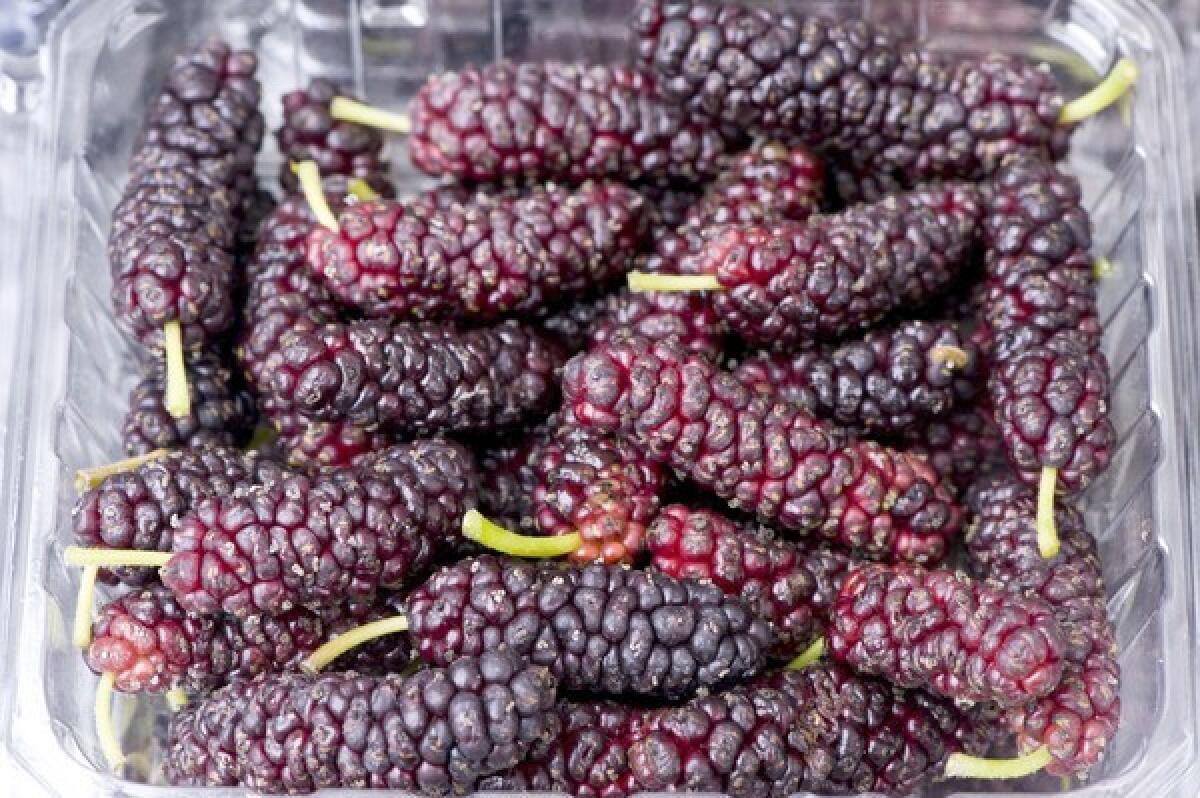Market Watch: Deliciously strange Pakistan mulberries

- Share via
Almost everyone who sees a Pakistan mulberry for the first time exclaims, “Oh, my gosh, what is that?” It certainly is bizarre looking, a long, thin, purplish, snakelike fruit, anywhere from 1 to 5 inches long, with 3 inches being typical. Although not yet exactly common at farmers markets, they’re not nearly as rare as they used to be even a few years ago.
Aside from looking weird, they’re quite delicious, with a mild, fruity flavor and a good balance of sweetness and acidity. One eats this berry as one might a satay, grabbing the stem and stripping the flesh off with one’s teeth from the long, stringy central core, which is edible but not particularly pleasant. Both for growers and consumers, a major advantage of the Pakistan, compared with the more celebrated Persian type, is that it is firmer and has stronger skin, so that it remains reasonably dry during picking, packing and sale, and thus has a longer storage life, two or three days if refrigerated.
Even so, the Pakistan mulberry is often confused with the Persian, which is very different — it’s another species, Morus nigra, native to southwestern Asia, which ripens about a month later, in late June and July. It is round or oval in shape, leaks a dark, staining juice quite readily, and has a far more intense sweet-tart flavor.
The Pakistan’s season is May to mid-June, a bit later at higher elevations. It is a variety of M. macroura, native to the forests of its namesake country and India, and closely related to M. alba, the white mulberry; in the past it was sometimes considered to be just a subspecies of M. alba, the fruit of which is consumed fresh and dried across southern Asia, while the leaves serve as fodder for silkworms.
White mulberries are also now in season, and sometimes show up at farmers markets. The name is actually a misnomer, since fruit can be white, black, light purple or pinkish. Certain varieties of white mulberries can be tasty, but usually the fruits are merely sweet, with none of the balancing acidity or complexity of flavor that would make them interesting.
When buying Pakistan mulberries, as with almost every fruit, ripeness is critical: the darker the berry, the sweeter and richer the flavor. Buying light reddish fruits is a waste of money, since they’ll be sour and bland, with an unpleasant vegetal taste. Some growers pick them immature because they’re afraid that if the berries ripen fully, they’ll fall off the tree or be devoured by birds, which are highly partial to the fruits.
The Pakistan first came to the United States in 1986, when Mike McConkey, owner of Edible Landscaping in Afton, Va., asked George A. White of the U.S. Department of Agriculture to import promising mulberry varieties. Cuttings of this variety arrived from the Pakistan Agriculture Research Center in Islamabad without a local name, so the variety has been called after its country of origin.
Recently, Jiminez Family Farm of Santa Ynez, which sells at Hollywood, Santa Monica (Wednesday) and Ventura (Saturday), has been bringing some of the best Pakistans, so ripe they’re almost black, and ever so slightly on the dry side, giving them a rich, concentrated flavor not always present in this variety. At Santa Monica (Wednesday and Saturday organic), Coleman Family Farms of Carpinteria also sells very fine specimens, large, plump and ripe; on Wednesday, Chris Jacobson, chef of the Yard, scooped up most of the available berries. Other vendors who often bring good Pakistans include Pudwill Farms of Nipomo and Mud Creek Ranch of Santa Paula, both of whom sell at Santa Monica and Hollywood.
More to Read
Eat your way across L.A.
Get our weekly Tasting Notes newsletter for reviews, news and more.
You may occasionally receive promotional content from the Los Angeles Times.








